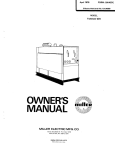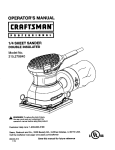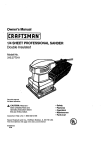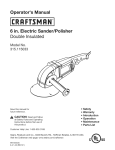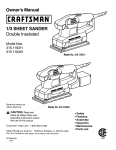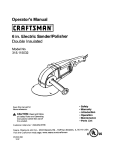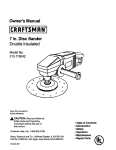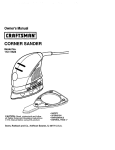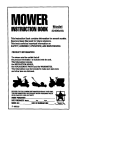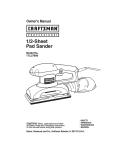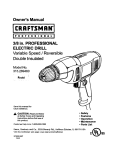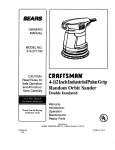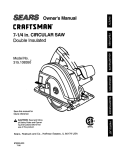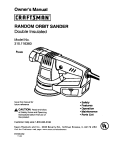Download Craftsman 315.116320 Owner`s manual
Transcript
Owner's Manual II::RRFTSMRN'I 1/3 SHEET SANDER Double Insulated Model Nos. 315.116310 315.116320 ModelNo.315.116310 Save this manual for future reference Model No. 315.116320 CAUTION: Read and follow all Safety Rules and Operating Instructions before first use of this product. • Safety • Features • Assembly • Operation • Maintenance Customer Help Line: 1-800-932-3188 Sears Roebuck and Co., Hoffman Estates, IL 60179 USA Visit the Craftsman web page: www.sears.com/craftsman 972000-506 12-98 • Parts List (_o NRTL TABLE O_ CONTENTS Is' General Safety Rules ................................................................................................................................................. 2-3 • SpecificSafety Rules/Symbols ............................................................................................................................... • Features ...................................................................................................................................................................... 5-6 • Assembly.................................................................................................................................................................... 7-9 • "Operation.................................................................................................................................................... ..3-4 ;............. 9:;10 • Maintenance................................................................................................................................................................ 11 • Accessories ................................................................................................................................................................. 11 • ExplodedView And Repair Parts List .................................................................................................................... • Parts Ordering / Service .............................................................................................................................................. A WARNING: Read end understand all Instructions. Failure to follow all instructions listed • below, may result in electric shock, fire and/or serious personal injury. Don't expose power tools to rain or wet conditions. Water entedng a power tool will increase the dsk of electdc shock. carry the tools or pull the plug from an outlet. Keep cord away from heat, o11,sharp edges or moving parts. Replace damaged cords Immedlafely. Damaged cords increase the risk of electdc shock. Work Area • Keep your work area clean and well lit. Gluttered benches and dark areas invite accidents. • Do not operate power tools I_n explosive atmospheres, such as in the presence of flammable liquids, gases, or dust. Power tools create sparks which may ignite the dust or fumes. • • Keep bystanders, children, and vleltore away while operating • power tool. Distractions can cause you to lose control. Personal Safety Double Insulated tools are equipped with a poladsed plug (one blade is wider than the other.) This plug will fit In a polarized outlet only one way. If the plug does not fit fully in the outlet, reverse the plug. If It atlll does not fit, contact a qualified electrician to Install a polarized outlet. Do not change the plug In any way. Double insulation [] eliminates the need for the three wire grounded power cord and grounded power supply system. Avoid body contact with grounded surfaces such as pipes, radiators, ranges and refdgeratore. There is an increased risk of electric shock if your body is grounded. 2 When operating a power tool outside, use an outdoor extension cord marked "W-A" or "W". These cords are rated for outdoor use and reduce the risk of electdc shock. • Stay alert, watch what you are doing and use common sense when operating a power tool DO not use tool while tired or under the Influonce of drugs, alcohol, or medication. A moment of inattention while operating power tools may result in serious personal injury. • Dress properly. Do not wear loose clothing or jewelry. Contain long hair. Keep your hair, clothing, and gloves away from moving parts, Loose clothes, jewelry, or long hair can be caught in moving parts. • Avoid accidental starting. Be sure switch Is off before plugging In. Carrying tools with your finger on the switch or plugging in tools that have the switch on invites accidents. Electrical Safety • 16 Do not abuse the cord. Never use the cord to SAVE THESE INSTRUCTIONS i 14-15 • Remove adjusting keys or wrenches before turning the tool on. A wrench or a key that is left attached to a rotating part of the tool may result in personal injury. • Store Idle tools out of reach of children end other untrained persons. Tools are dangerous in the hands of untrained users. • Do not overreach. Keep proper footing end balance at ell tlmee. Proper footing and balance enables better control of the tool in unexpected situations. • Maintain tools with care. Keep cuffing tools sharp and clean. Pmpedy maintained tools, with : sharp cutting edges are less likely to bind and are easier to control. • Use safety equipment. Always wear eye protection. Dust mask, nonskid safety shoes, hard hat, or hearing protection must be used for appropriate conditions. • Check for mlsallgnment or binding of moving parts, breakage of parts, and any other oondition that may affect the tools operstlon. If damaged, have the tool serviced before using. Many accidents are caused by poorly maintained tools. • Use only accessodes that are recommended by the manufacturer for your model. Accessodes that may be suitable for one tool, may become hazardous when used on another tool. • Use clamps or other practlcel way to secure end support the workplece to a stable platform. Holding the work by hand or against your body is unstable and may lead to loss of control. Do not force tool. Use the correct tool for • • your application. The correct tool will do the job better and safer at the rate for which it is designed. Do not usa tool if switch does not turn It on or Tool service must be performed only by qualified repair personnel. Service or maintenance performed by unqualified personnel could result in a risk of injury. (_)ff.Any tool that cannot be Controlled with the S_'itch is dangerous and must be repaired. • When servicing • tool, usa only Identical replacement parts. Follow Inatructlons In Maintenance section of this manual. Use of Tool Use and Care • • SERVICE Disconnect the plug from the power source before meldng any edJuatments, changing accessories, or atorlng the tool. Such preventive safety measures redUce risk of starting the tool accidentally. unauthodzed parts or failure to follow Maintenance Instructions may create a risk of electric shock or injury. 3 SpecificSafetyRulesfor Sanders • parts, mounting, and any other conditions that may affect Its operation. A guard or other part _ that Is damaged should be progerly repaired or replaced by an authorized service center. Following this rule will reduce the risk of electric shock, fire, or serious injury. Never use this or any power sander for wet sanding or liquid polishing. Failure to comply will increase the risk of electrical shock. Additional Rules for Safe Operstlon • Know your power tool. Read operator's manual carefully. Learn Its applications and limitations, as well as the specific potential hazards related to this tool. Following this rule will reduce the risk of electric shock, fire, or serious injury. • Always wear safety glasses. Everyday eyeglasses have only Impact-resiatant lenses; they are NOT safety glasses. Following this rule will reduce the risk of personal injury. • Protect your lungs. Wear a face or dust mask if the operation Is dusty. Following this role will reduce the risk of personal injury. • Don't abuse cord. Never carry the tool by the cord or yank It to disconnect It from the receptacle. Keep cord away from heat, oil, and sharp edges. Following this rule will reduce the risk of electric shock or fire. • Make sure your extension cord Is In good condition. When using an extension cord, be sure to use one heavy enough to carry the current your product will draw. A wire gage size (A.W.G.) of at least 16 Is recommended for an extension cord 100 feet or less In length. A cord exceeding 100 feet is not recommended. If in doubt, use the next heavier gage. The smaller the gage number, the heavier the cord. An undersized cord will • Protect your hearing. Wear hearing protection during extended periods of operation. Fo$$owing this rule will reduce the risk of personal injury. • Inspect tool cords periodicelly and, If damaged, have rspelrsd at your nearest Factory Service Center or other Authorized Service • Organization. Constantly stay aware of cord location. Following this rule will reduce the risk of electric shock or fire. Inspect for and remove all nails from lumber before sanding. Following this rule will reduce the risk of personal injury. • Check damaged parts. Before further use of the tool, a guard or other part that Is damaged should be carefully checked to determine that It will operate properly and perform Its Intended function. Check for alignment of movIng parts, binding of moving parts, breakage of Drugs, alcohol, medication. Do not operate tool while under the Influence of drugs, alcohol, or any medlcetlon. Following this rule wI!l reduce the risk of electnc shock, fire, or personal injury. • Savethese Inatructions. Refer tothem frequently and use them to Instruct others who may use this tool. If you loan someone this tool, loan them these Inatructlons also. This will reduce the • cause a drop in line voltage resulting in loss of power and overheating. risk of fire, shock, and injury. SYMBOLS •. SYMBOL NAME DESIGNATION/EXPLANATION V Volts Voltage A Amperes Current Hz Hertz Frequency(cycles per second) W Watt Power min Minutes Time AlternatingCurrent Type or a characteristicof current no No Load Speed Rotational speed, at no load [] Class II Construction Designates Double Insulated Constructiontools .../min Revolutionsor ReciprocationPer Minute Revolutions,strokes, surface speed, orbits etc. per minute _k Safety Alert Symbol Indicatesdanger, warning or caution. It means attentionU!Your safety is involved. DEFINITIONS A) DANGER: Failure to obey a safety waming will result in seriousinjuryto yourselfor to others. Always followthe safety precautionsto reducethe riskoffire, electricshockand personalinjury. B) WARNING: Failureto obey a safety warning can result in serious injuryto yourselfor to others. Always followthe safetyprecautionsto reducethe riskoffire, electricshockand personalinjury. C) CAUTION: Failure to obey a safety waming may result in propertydamage or personal injury to yourself or to others. Always follow the safety precautionsto reduce the risk of fire, electric shock and personal injury. D) NOTE: Advisesyou of informationor instructionsvital to the operation or maintenance of the equipment. KNOWYOURSANDER ELECTRICAL See Figure 1. Your sander has a precisionbuiltelectric motor.It should be connected to a power supply that Is 120 volts, 80 Hz, AC only (normal household current). Do not operate this tool on directcurrent (DC). A substantialvoltage drop will cause a foss of power and the motorwilt overheat, if your tool does not operate when plugged intoan outlet, double-checkthe power supply. Before attempting to use your sender, familiarize yourself with all operatingfeatures and safety requirements. Your sender is suitable for sending with coarse, medium, and fine gilt sandpaper. It will produce a fine scratchfree finish when used to send with the grain on wood surfaces. It has also been designedso that sanding flush to comers is possible. CONNECTION PRODUCT SPECIFICATIONS APPLICATIONS No Load Speed (Use only for the purposes listed below) Rating Input Model No. 116310 Model No. 116320 • Sanding on wood surfaces. • Removing rust from and sandingsteel surfaces. SW_CH This tool is equipped with a slide switch located on the rear handle of your sander. To tum sander ON, slide the switch forward as shown in Figure 1. Stide the sw_tch back to turn your sander OFF. Be sure sander switch is in OFF positionbefore connectingto power supplysource. DUSTLESS 1/16 in. Size of Paper 113sheet Non-AdhasiveSandpaper Adhesive Sandpaper Model No. 116320 Dustless Vacuum Hose Adaptor A dust bag assemblyand a vacuumhose adapteris Includedwith yoursender. Each providea dust collection systemfor yoursander. 1.8 Amperes 2.0 Amperes Orbit Diamter Paper Type FEATURE (Model No. 315.116320) 12,000 opm 120 Volts,60 Hz, AC only Model No. 116320 _IL WARNING: Do not allow familiaritywith your sender to make you careless. Remember that a careless fraction of a second is sufficientto inflict severe injury. TOTURN SANDERON SWITCH SWITCH REAR HANDLE TOTURN SANDEROFF DUSTBAGASSEMBLY (MODELNO.315,116320) HANDLE VACUUMHOSEADAPTER (MODELNO,315.116320) CUSHION PAPERCLAMP LEVER 6 Fig. 1 _ WARNING: Your sander should never be connected to power supply when you are assembling parts, making adjustments,assemblingor replacing sandpaper, cleaning, or when not in use. Disconnecting your sander will prevent accidental starting that could cause serious personal injury. INSTALLING SANDPAPER See Figures 2 and 3. The cushionon yoursandergivesyou the optionof using eithernon-adhesivesandpaperthat damps to the platen;or adhesivebacked sandpaper with pressuresensitiveadhesivebackingthat sticksto the cushion. INSTALLING NON-ADHESIVE See Figure 2. • Unplugyour sander. _k WARNING: Failure to unplugyour sander could result in accidental starting causing possiblesadous ' personal injury. SLOT PosmoN • Wrap sandpaper around cushionand insertloose end of sandpaper under the rear paper clamp. Fit sandpaperagainst cushion as tightas possible. • Lift up on lever located on right side of sander and lock into slot in platen. INSTALLING ADHESIVE See Figure 3. SANDPAPER • Unplug your sender. WARNING: Failure to unplugyour sander could result in accidental starting causing possiblesadous personal injury. SANDPAPER Inspectsandpaper before installing.Do not usa if broken or defective. PAPERCLAMP IN UNLOCKED • Lift up on lever on the left side of sander and lock into. slot on platen. Apply downwardpressureto conform sandpaper to platen. • If replacing adhesive sandpaper, remove old sandpaper by peeling it off cushion. If removingnonadhesive sandpaper, release paper clamp by liftingup on each lever, then remove sandpaper. • Place levers back in locked position. Note: Always check to make sure levers are in locked position before turning sander on. • Carefully peel adhesive backing from new 1/3 sheet sandpaper. • : Position sandpaper, making sure front edge of sandpaper is aligned with front edge of the cushion, then carefully press sticky side of sandpaper on cushion. Note: Sandpaper must be aligned with the front edge of the cushion for proper functioning of the flush sanding feature. Note: It is recommended that you clean cushionoccasionally by brushinglightlywith a small brush. Dust butid-uP on cushioncould cause sandpaperto not stick propsdy: NON-/_HE_VIE SANDPAPER LEVER Fig.2 Note: If yoursander iSModel No. 315.116320, removingthe dust bag assemblywillmake installingnon-adhesive sandpaper easier. Always remember to replace the dust bag assemblybeforebeginningoperation. • If replacingsandpaper,remove old sandpaper. To remove sandpaper, a lever is located on each side of your sender. Release paper clamps secudng sandpaper by liftingup on each lever end disengaging from slot in platen. • Insert end of new 1/3 sheet sandpaper approximately11 2 inch under the front paper clamp. ADHESIVE SANDPAPER Fig. 3 ATTACHINGDUSTBAGASSEMBLY (ModelNo.315.116320) TO REMOVE AND EMPTY DUST BAG See Figure 5. See Figure 4. • DUSTSAG Unplugyoursander. WARNING: Failure to unplugyour sander could resultin accidental starting causing possiblesedous personalinjury. • Remove dust bag assembly from sander. To remove, grasp adapter and pull straight out. • Then remove dust bag from adapter as shown in figure 5. • Shake dust bag to empty. DUSTBAG ADAPTER • • Attach dust bag assembly back on sander. EXHAUSTHOLE MODELNO, 116320 Fig. 4 _1= WARNING: To preventthe possibil_ of sanding dust or foreignobjectsbeing thrown intoyour face or ,eyes,never attemptto use your sander without the dust bag assembly properlyinstalled. Sanding dust or foreignobjects being thrown into your face could resultin possibleserious personal injury. • _lb Place dust bag back on adapter, Unplug your sender. WARNING: Failure to unplug your sender could result in accidental starting causing possible serious personal injury. • Insertdust bag adapter intodust exhaust hole. See Figure 4. • Push in on adapter until raised notches on top and bottomof adapter snap intogrooves in dust exhaust bole. • Your sender is now ready for operation. Note: For more efficientoperation,empty dust bag when no more than half full. This will permitthe air to flow throughthe bag better. Always empty and clean dust bag thoroughly when finishedsandingoperation and before storing sander. DUSTBAG / DUSTBAG ADAPTER DUST EXHAUSTHOLE MODELNO. 116320 Fig. 5 ATTACHING VACUUMHOSEADAPTER (ModelNo,315.116320) WARNING: Always wear safety gogglesor safety glasses with side shields when operating your sander. Failure to do so could result in foreign objectsbeing thrown into youreyes, resultingin possiblesedous injury. If the sanding operationis dusty, also wear a face or dust mask. See Figure6. A vacuum hose adapter is packed with sander Model No. 315.116320. This adapter easily attachesto your sander if you decide to connectyour sander to a vacuum. • Unplugyoursander, PREPARING FOR OPERATION _1= WARNING: Failure to unplug your sander could resultin accidental starting causing possiblesedous personal injury. ,_ TO ATTACH: SANDING • Clamp or otherwise secure the work to prevent itfrom moving under your sander. Remove dust bag assembly from sander. To remove, grasp adapter and pull straight out. M insert vacuum hose adapter into dust exhaust hole. • Push in on adapter until raisednotch on top and bottom of adapter snap into groove in dust exhaust hole. M Snugly attach vacuum hose adapter to vacuum hose. B Connect vacuum hose to cleaner. VACUUMHOSE ADAPTER CAUTION: air vents. Be careful not to let your hand cover the _1= WARNING: Unsecured work could be thrown towards the operator causing injury. Hold your sander in front and away from you, keeping it clear of the workpiece. Start your sander by slidingthe switchbutton to the on position and lettingthe motorbuild to its maximum speed. Gradually loweryour sander on the work with a slight forward movement.See Figure 7. Move it slowly usingforward and backwardstrokes. RAISED NOTCH EXHAUSTHOLE MODEL NO. 116320 --' Fig. 6 Fig. 7 Do not force. The weight of the unitsupplies adequate pressure, so let the sandpaper and sander do the work. Applyingadditional pressure only slows the motor, rapidly wears sandpaper and greatly reduces sander speed. Excessive pressure will overloadthe motorcausing possibledamage from motor overheatingand can resultin infedor work.Any finish or resin on wood may soften from the frictional heat. Do not allow sanding on one spot too long as the sander's rapid action may remove too much material, making the surface uneven. SANDPAPER SELECTION selecting thecorrectsizegdtandtypesandpaper isan extremely importantstep in achievinga high quality sanded finish.Aluminumoxide, siliconcarbide, and other syntheticabrasivesare best for power sanding. Natural abrasives, such as flint and garnet are too soft for economical use in power sanding. Flush sanding can be performedwith your sander. See Figure 9. Every side except the rear of your sander allows flush sanding in comers. Always remove sander from workplece before turning your sander off. .ha In general, coarse gdt will remove the most material and . finer grit will producethe best finish in all sanding operafions. The condition of the surface to be sanded will determine which gdt will do the job. If the surface is rough, start with a coarse grit and sand until the surface is uniform.Medium grit may then be used to remove scratches left by the coarser grit and finer gdt used for finishingof the surface.Always continue sandingwith each grit untilsurface is uniform. Note: Do not use sander without sandpaper. Doing so will damage the cushion. ,_ WARNING: Do not wear loose clothingor jewelry ,whenoperatingsander. They could get caught in moving parts causing sedous injury. Keep head away from sander and sanding area. Hair could be drawn intosander causing serious injury. Fig. 9 REMOVING SANDPAPER ORBITAL MOTION See Figure 8. BEFORE STORAGE Do not store your sander with pressure sensitiveadhesive sandpaper installed. Heat generated from sanding causes the pressuresensitive adhesive to flow and form a tight bend between the cushionand sandpaper. Orbital motion is ideal for fast cutting actionwhen removingold finishes,smoothingroughwood, cutting stock downto required dimensions,or for finishing surfaces to be painted. As shown in figure B. the sandpaper moves in tiny circlesat a very high speed, allowingthe sander to move easily. _::_" _Jr Removingthe sandpaper soon after you have finisheda sanding operation avoids letting the adhesive set up. If the sandpaper Is left on the cushionfor an extended pedod of time after use, the adhesive will set up and cause the sandpaper to become difficultto remove. It may also tear when removing.When this situation occurs, It becomes difficultto clean the cushionfor the next piece of sandpaper. Note: If you forget to remove the sandpaper after a sanding operation, sand for a few minutesto soften the adhesive backing before attempting to remove sandpaper. ORBITALMOTION Fig. 8 10 _IL WARNING: When servicing use only Identical Craftsmen replacement parts, Use of any other parts may create a hazard or cause productdamage. GENERAL All parts represent an importantpart of the double insulationsystem and shouldbe servicedonly by a qualified Sears service technician. Avoid using solventswhen cleaning plasticpads. Most plastics are susceptibleto damage from various types of commercial solventsand may be damaged by their use. Use clean clothsto remove dirt, carbon dust, etc. A WARNING: Do not at any time let brake fluids, gasoline, patroleum-besed products,penetrating oils, etc. come in contactwith plasticpads. They contain chemicals that can damage, weaken, or destroy plastic. it has been found that electrictoolsare subjectto accelerated wear and possiblepremature failure when they are used on fiberglassboats, sportscars, wallboard, spacklingcompounds, or piaster. The chips and gdndings from these matedais are highlyabrasive to electrictool pads such as beadngs, brushes, commutators,etc. Consequently, it is not recommendedthat this tool be used for extended work on any fiberglassmaterial, wallboard, spacklingcompounds, or plaster. Dudng any use on these materials it is extremely importantthat the tool is cleaned frequentlyby blowingwith an air jet. EXTENSION CORDS The use of any extension cord willcause some loss of power. To keep the loss to a minimum and to preventtool from overheating,use an extension cord that is heavy enough to carry the current the tool will draw. A wire gage size (A.W.G,) of at least 16 is recommended for an extension cord 100 feet or less in length.When workingoutdoors,use an extension cord that is suitable for outdoor use. The cord'sjacket willbe marked WA. _l CAUTION: Keep extension cords away from the sanding area and positionthe cord so that it will not get caught on lumber, tools, etc., during sanding. _1= WARNING: Check extension cords before each use. If damaged replace immediately.Never use tool with a damaged cord since touchingthe damaged area could cause electdcal shock resultingin serious injury. Extensioncords suitable for use with your sander are available at your nearest Sears Retail Store. WARNING: Always wear safety goggles or safety glasses with side shields dudng power tool operation or when blowingdust. If operation is dusty, also wear a dust mask. LUBRICATION All of the beadngs in this tool are lubricatedwith a sufficientamount of high grade lubricantfor the life of the unit under normal operating conditions.Therefore, no further lubdcationis required, The followingrecommendedacoessodesare currentlyavailable at Sears Retail Stores. ALUMINUM OXIDE SHEETS NON LOADING ALUMINUM OXIDE (3-2/3 In. x 9 In.) ADHESIVE BACKED (3-2/3 In. x 7-1/8 In.) Extra Fine Fine Fine Medium Medium Coarse Coarse _1= WARNING: _t The use of attachments or accessories not listedmight be hazardous. WARNING: The operation of any sander can result in foreign objectsbeing thrown into your eyes, which can resultin severe eye damage. Before beginning power tool operation,always wear safety goggles or safety glasses with side shields and a full face shield when needed. We recommend Wide Vision Safety Mask for use over eyeglasses or standard safety glasses with side shields, available at Sears Retail Stores. 11 WARRANTY FULLONEYEARWARRANTY ONCRAFTSMAN SANDER MODEL NO.316.116310 IfthisCRRFTSNAN Sanderfailstogivecomplete satisfactionwithin one year from the date of purchase, RETURN IT TO THE NEAREST SEARS STORE IN THE UNITED STATES, and Seam will replace it, free of charge. If this CRAFT$MRH Sander is used for commercialor rental purposes, this warrantyapplies for only 90 days from the date of purchase. This warranty gives you specific legal rights,and you may also have other dghtswhich vary from state to state. Sears, Roebuck end Co., Dept. 817WA, Hoffmen Estates, IL 60179 WARRANTY FULL ONE YEAR WARRANTY ON CRAFTSMAN SANDER MODEL NO, 315.116320 If this rRRFrSNRN Sander fails to give completesatisfactionwithin one year from the date of purchase, RETURN IT TO THE NEAREST SEARS STORE IN THE UNITED STATES, and Sears will repair it, free of charge. If this CRAFTSMAN Sander is used for commercial or rental purposes,this warrantyapplies for only 90 days from the date of purchase. This warranty gives you specificlegal dghts, and you may also have other rightswhich vary from state to state. Sears, Roebuck and Co., Dept. 817WA, Hoffman Estates, IL 60179 12 NOTES: 13 CRAFTSMAN SANDER - MODEL NOS. 315.116310 AND 315.116320 SEE NOTE "A" PAGE 15 1 I ! I , L--_7 4 14 CRAFTSMAN [ SANDER - MODEL NOS. 315.116310 AND 315.116320 The in allmodelnumberwillbe correspondence regardingyour found on a plate SANDER attaohodtothe or when orderingrepair motor housing,Alwaysmention parts. the model number I SEE BACK PAGE FOR PARTS ORDERING INSTRUCTIONS PARTS LIST Key No. Part Number Description 1 977307-001 977271-001 Data Plate (Model No, 315.116310) ........................ 1 Date, Plate (Model No. 315,116320) ........................ 1 2 977308-001 977272-001 Logo Plats (Model No. 315.116310) ....................... 1 Logo Plate (Model No, 315.116320) ....................... 1 3 977265-001 Dust Shield (Model No. 315.116320) ...................... 1 4 977266-001 Paper Clamp............................................................ 2 5 623019-004 Rubber Plug............................................................. 1 6 977267-001 Platen ....................................................................... 1 7 617966-028 Screw (#8-10 x 1/2 in. Pan Hd.) .............................. 4 8 977268-001 977268-002 Cushion (Model No. 315.116320) ........................... 1 Cushion (Model No. 315.116310) ........................... 1 9 "** 10 976967-002 Vacuum Hose Adapter (Model No. 315.116320) .... 1 11 989919-005 Ball Beadng ............................................................. 12 977270-001 Dust Bag Assembly(Model No, 315.116320) ......... 1 972000-506 Owner's Manual Quan. Sandpaper 1 NOTE: "A"- The assembly shown represents an Important part of the Double Insulated System. To avoid the posslblllty of alteration or damage to the system, servlce should be performed by your nearest Sears Repalr Center. Contact your nearest Sears Retell Store for Barvlce Center Information. * Standard Hardware Item - May Be Purchased Locally *** Complete Assortment Available At Your Nearest Sears Retail Store i i 15 For in-home major brand repair service: Call 24 hours a day, 7 days a week 1-800-4-MY-HOME Para pedir servicio de reparacibn s" (1-800-469-4663) a domicilio - 1-800-676-5811 In Canada for all your service and parts needs call - 1-800-665-4455 Au Canada pour tout le service ou les pi_ces For the repair or replacement parts you need: Call 6 am - 11 pm CST, 7 days a week PartsDirects. 1-800-366-PART Para ordenar piezas con entrega (1-800-366-7278) a domicilio - 1-800-659-7084 For the location of a Sears Parts and Repair Center in your area: Call 24 hours a day, 7 days a week 1-800-488-1222 For information on purchasing a Sears Maintenance Agreement or to inquire about an existing Agreement: Call 9 am - 5 pm, Monday - Saturday 1-800-827-6655 The Service Side of Sears
















